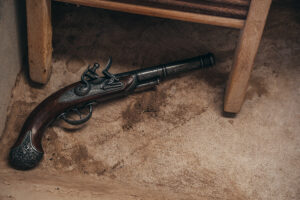
Popular Colonial Firearms
The colonial period in American history was marked by the use of firearms crucial for survival, defense, and expansion. These firearms evolved alongside the colonists’ needs and experiences, leaving an indelible mark on the shaping of the nation. This paper explores three popular colonial guns—the musket, flintlock pistol, and long rifle—and their roles in colonial life and the American Revolution. The Musket The musket was the primary firearm colonial militias and British regulars used during the 18th century. Musket technology evolved from the matchlock to the flintlock mechanism, allowing quicker and more reliable firing. It featured a smoothbore barrel and fired lead balls or shot. The musket was instrumental in colonial conflicts, including the French and Indian War and the American Revolution. It allowed for mass volleys of fire, transforming warfare tactics. It became a symbol of the military might of colonial powers. The musket’s design also laid the foundation for future military rifles. However, its prevalence in colonial America cemented firearms as a crucial aspect of American culture. So much so that two muskets, the Brown Bess and Pennsylvania long rifle, continue to be celebrated in American history and popular culture. The Flintlock Pistol Flintlock pistols were popular among colonial officers, civilians, and pirates due to their compact size and portability. They were often used for self-defense and as symbols of authority. Flintlock pistols were carried by colonial leaders like George Washington and Thomas Jefferson, and they played a symbolic role in duels and honor culture. Early flintlock pistols had rudimentary designs and needed to be more reliable. Later models, such as the “Queen Anne” pistol, featured improved mechanisms and craftsmanship. Their design paved the way for the development of more advanced handguns. The Long Rifle The long rifle, often called the Kentucky or Pennsylvania rifle, was renowned for